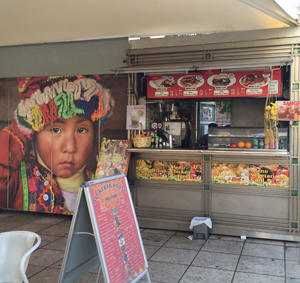
Recent weeks have been very busy for the Welfare Bricolage Project (UPWEB) and have seen us meeting as a full team for the first time. The project began on the 1st of January and we have all been busy since then putting in the foundations for our country case studies. We have each recruited at least one Research Fellow, scoped out our study sites and launched our projects in our cities. In the UK we held an event in association with our BA Leverhulme Health Histories Project and were able to hear from a wide variety of people working in health provision about how we could share our findings with them. We were pleased to hear that they are as excited about the project as we are. Elsewhere colleagues have been visiting local NGOs, policymakers and practitioners to spread the news about our upcoming work and to try to identify potential community researchers.
As well as walking the streets of our case study neighbourhoods we have also been doing a lot of desk based work. In particular each partner has been creating a detailed neighbourhood profile that details everything we need to know about the demographics, socio-economic, health, environmental, political and structural features of our neighbourhoods. We all have different data sources and use different units of analysis which means we cannot directly compare our neighbourhoods. For example in Sweden information is not collected by ethnicity while in the UK we have a long tradition of using ethnic origin categorisations. Our profiles and the photos we have shared on our neighbourhoods have provided us all with insights about each area.
This insight was hugely helped by the Research Fellow slam that each of the projects participated in before an audience of academics and students in Lisbon. We were able to see the physical differences and connect the economic data with many maps and photos of the neighbourhoods. It’s clear that while they share certain features; their populations are all superdiverse, there are pockets of deprivation and wealth; they are also different. The Swedish neighbourhoods are smaller and more recently built and extremely green looking to us, more like rural areas than diverse suburbs. In Birmingham the neighbourhoods are long established and quite densely populated. They might be described as inner-city neighbourhoods with Handsworth having a clear indications of a lively street life and the other much quieter. In Germany the neighbourhood of Neustadt, on its way to being gentrified, was interesting because it is bounded by urban infrastructure and looks like an urban island surrounded by cars and trains. We were lucky to be taken on a tour of Mouraria in Lisbon. Its tightly packed streets made Handsworth look spacious. There was no room for cars but plenty of indication of recent renewal even the introduction of a short trail celebrating the birth of Fado in that part of Lisbon. Our tour guide a Bengali migrant, who had formerly lived in London, took us into an indoor market where we saw different foodstuffs and clothing for sale.
The Mouraria tour was just a tiny part of the Lisbon team meeting. We had much serious business to do. Our first day was spent working on the focus of the topic guide that we will all be using to explore the process of bricolage from the perspectives of residents living in our neighbourhoods. Bringing fifteen people together from different countries and disciplines (political science, medical sociology, medical anthropology, social policy, geography, anthropology, epidemiology) there were always going to be some challenges. We spent much time discussing the focus of our interviews and whether we should include even those living in gated communities: we decided we should include all residents as they will have different approaches to health-seeking. We had to constantly remind ourselves that we were looking at all residents and not just migrants whom, for some of us, had been the main focus of our previous work. We also had to explore some difficult issues around how to elucidate the process of health-seeking from our respondents without going into huge detail about any illness they may have had. Put simply we are interested in what they do, when they do it, why they do it and the influences on their actions rather than their symptoms or medications.
After lengthy discussions about what constituted health, whether we included psychological health, maternity and well-being we decided at the early stages of the project to keep our questions as open as possible. We have settled upon Since you‘ve been living in this area when were you last ill or had a health worry and felt you needed to get some help? as an opening question for now, but will be piloting the full topic guide with the help of our community researchers in the next few weeks. Subsequent days were spent in training sessions focusing on teaching our project team how to train community members to undertake (paired) ethnographic interviews which is a key part of the early fieldwork – the interviews start in July. After a final meeting in which we discussed some of the conceptual and methodological dilemmas we had identified with our International Advisory Board – our first of three such meetings – we headed back to our respective countries exhausted after three long and intense days of activity but having made progress in terms of taking the project forward and in cohering as an interdisciplinary team. Now onto those post-meeting action points....
Professor Jenny Phillimore, j.a.phillimore@bham.ac.uk